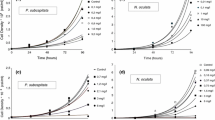Abstract
The cytotoxic and genotoxic effects induced by trichloroisocyanuric acid, Oxone®, and sodium bromide, active principles included in formulations for cleaning and disinfection of cooling towers, were studied on RTG-2 cell line. Neutral red assay was used to determine the cellular viability. Toxicity ranking based on IC50 values found that trichloroisocyanuric acid was the most cytotoxic biocide tested followed by Oxone®, whereas sodium bromide resulted in a very low cytotoxicity. DNA damage has been evaluated on RTG-2 cultures by means of an in vitro assay based on the ability of PicoGreen® fluorochrome to interact preferentially with dsDNA, and the results indicated that trichloroisocyanuric acid induced DNA strand breaks at concentrations above 1.2 mg/l, equivalent to 1/50-EC50(48), whereas exposures to Oxone® and sodium bromide did not induce DNA damage at the maximal concentrations tested (1/10-EC50(48)). These results confirm the suitability of this method for the screening of genotoxic effects of this type of aquatic pollutants, and we suggest their use in environmental risk assessment procedures.


Similar content being viewed by others
References
Batel R, Jaksic Z, Bihari N, Hamer B, Fafandel M, Chauvin C, Schröder HC, Müller WEG, Zahn RK (1999) A microplate assay for DNA damage determination (Fast Micromethod) in cell suspensions and solid tissues. Anal Biochem 270:195–200
Bodek I, Lyman WJ, Reehl WF, Rosenblatt DH (1988) Environmental inorganic chemistry. Pergamon Press, Elmsford
Canton JH, Wester PW, Mathijssen-Spiekman EA (1983) Study on the toxicity of sodium bromide to different freshwater organisms. Food Chem Toxicol 21:369–378
Castaño A, Cantarino MJ, Castillo P, Tarazona JV (1996) Correlations between RTG-2 cytotoxicity test EC50 and in vitro LC50 rainbow trout assay. Chemosphere 32:2141–2157
Castaño A, Bols N, Braunbeck T, Dierickx P, Halder M, Isomaa B, Kawahara K, Lee LEJ, Mothersill C, Pärt P, Repetto G, Sintes JR, Rufli H, Smith R, Wood C, Segner H (2003) The use of fish cells in ecotoxicology. ATLA 31:317–351
England AC, Fraser DW, Mallison GF, Mackel DC, Skaliy P, Gorman GW (1982) Failure of Legionella pneumophila sensitivities to predict culture results from disinfectant-treated air-conditioning cooling towers. Appl Environ Microbiol 43:240–244
Fisher DJ, Burton DT, Yonkos LT, Turley SD, Ziegler GP (1999) The relative acute toxicity of continuous and intermittent exposures of chlorine and bromine to aquatic organisms in the presence and absence of ammonia. Water Res 33:760–768
Freshney JR (1994) Culture of animal cells: a manual of basic techniques. Wiley–Liss, New York
Golaszewski G, Seux R (1994) The kinetics of the action of chloroisocyanurates on three bacteria: Pseudomonas aeruginosa, Streptococcus faecalis and Staphylococcus aureus. Water Res 28:207–217
Guan LL, Kuwahara J, Sugiura Y (1993) Guanine-specific binding by bleomycin-nickel(III) complex and its reactivity for guanine-quartet telomeric DNA. Biochemistry 32:6141–6145
Hammond BG, Barbee SJ, Inoue T, Ishida N, Levinskas GJ, Stevens MW, Wheeler AG, Cascieri T (1986) A review of toxicology studies on cyanurate and its chlorinated derivatives. Environ Health Perspect 69:287–292
Haugland R (1992) Molecular probes handbook of fluorescent probes and research chemicals. Molecular, Probes, Inc., Eugene
Hegedus LS, Greenberg MM, Wendling JJ, Bullock JP (2003) Synthesis of 5,12-dioxocyclam nickel (II) complexes having quinoxaline substituents at the 6 and 13 positions as potential DNA bis-intercalating and cleaving agents. J Org Chem 68:4179–4188
Litchfield PH, Wilcoxon F (1949) A simplified method of evaluating dose-effect experiments. J Pharmacol Exp Ther 96:99−113
Mitchelmore CL, Chipman JK (1998) DNA strand breakage in aquatic organisms and the potential value of the Comet assay in environmental monitoring. Mutat Res 399:135–147
MHW (1997) Ministry of Health and Welfare: Japan Toxicity Testing Reports of Environmental Chemicals 5:429–442
OPP (2000) Pesticide ecotoxicity database. Environmental fate and effects division. U.S. E.P.A., Washington
Pharmacal Research Lab. Inc. (2004) Virkon-S EPA REG#62432-1 (MSDS HSD/US41), USA, 5 p
Poul JM, Huet S, Godard T, Sanders P (2004) Lack of genotoxicity of potassium iodate in the alkaline comet assay and in the cytokinesis-block micronucleus test. Comparison to potassium bromate. Food Chem Toxicol 42:203–209
Rachlin JW, Perlmutter A (1968) Fish cells in culture for study of aquatic toxicants. Water Res 2:409–414
Sánchez-Fortún S, Llorente MT, Castaño A (2005) Genotoxic effects of selected biocides on RTG-2 fish cells by means of a modified Fast Micromethod Assay. Aquat Toxicol 73:55–64
Sandbacka M, Christianson I, Isomaa B (2000) The acute toxicity of surfactants on fish cells, Daphnia magna and fish-A comparative study. Toxicol in vitro 14:61–68
Segner H, Lenz D, Hanke W, Schüürmann G (1994) Cytotoxicity of metals towards rainbow trout R1 cell line. Environ Toxicol Water Quality 9:273–279
Singer VL, Jones LJ, Yue ST, Haugland RP (1997) Characterization of PicoGreen reagent and development of a fluorescence-based solution assay for double-straned DNA quantitation. Anal Biochem 249:228–238
USEPA (1993) Reregistration eligibility document (RED): peroxy compounds. EPA 738-R-93-030. Office of Pesticide Programs, Special Review and Reregistration Division
USEPA (1998) Status of pesticides in registration, reregistration, and special review (Rainbow Report). Special Review and Reregistration Division Office of Pesticide Programs U.S. Environmental Protection Agency, Washington, 458 pp
Verquin G, Fontaine G, Bria M, Zhilinskaya E, Abi-Aad E, Aboukaïs A, Baldeyrou B, Bailly C, Bernier JL (2004) DNA modification by oxovanadium(IV) complexes of salen derivatives. J Biol Inorg Chem 9:345–353
Young SB, Setlow P (2004) Mechanisms of killing of Bacillus subtilis spores by Decon and Oxone, two general decontaminants for biological agents. J Appl Microbiol 96:289–301
Zeiger E, Andersson B, Haworth S, Lawlor T, Mortelmans K, Speck W (1987) Salmonella mutagenicity tests. III. Results from the testing of 255 chemicals. Environ Mutagen 9:1–110
Acknowledgements
The authors are grateful to Maria Luisa Cuellar for her technical assistance. This work was supported by Spanish Project MCYT BIO2002-01912.
Author information
Authors and Affiliations
Corresponding author
Rights and permissions
About this article
Cite this article
Sánchez-Fortún, S., Llorente, M.T. & Castaño, A. Cytotoxic and genotoxic effect in RTG-2 cell line exposed to selected biocides used in the disinfection of cooling towers. Ecotoxicology 17, 273–279 (2008). https://doi.org/10.1007/s10646-008-0194-0
Received:
Accepted:
Published:
Issue Date:
DOI: https://doi.org/10.1007/s10646-008-0194-0




